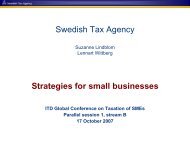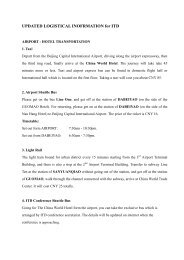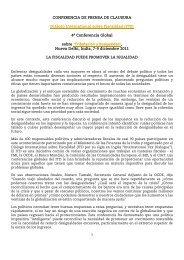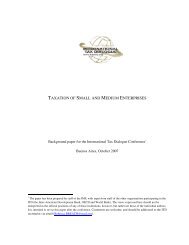Arcotia Hatsidimitris - International Tax Dialogue
Arcotia Hatsidimitris - International Tax Dialogue
Arcotia Hatsidimitris - International Tax Dialogue
Create successful ePaper yourself
Turn your PDF publications into a flip-book with our unique Google optimized e-Paper software.
ANNEX E – 105<br />
Annex E: Cloud computing<br />
The term “cloud” has been around for a while as a simple metaphor to represent a complex<br />
information technology infrastructure. Originally used to represent the telephone network, the cloud<br />
symbol is now commonly used to represent the Internet. “Cloud computing” is a generic term for the<br />
delivery of information technology services over the Internet. Probably the most basic form of cloud<br />
computing service is the provision of data storage. The user files information over the Internet and it<br />
is stored by the third party service provider. The user no longer has to worry about backing up their<br />
data as that is part of the service and the data are generally accessible to the user wherever they are<br />
able to access the Internet. On the other hand the user generally has no interest in, and frequently no<br />
control over, where the service provider chooses to locate the servers on which their data are stored.<br />
That does not mean that this cannot be specified in any agreement with a service provider if a<br />
particular user is concerned about the location of their data.<br />
Cloud computing services can extend well beyond the provision of data storage facilities over the<br />
Internet. There are three broad categories of cloud service provision. Infrastructure as a Service<br />
covers the provision of services such as data storage or access to server capacity that can substitute for<br />
the purchase of hardware. Platform as a Service takes the level of service further, replicating the<br />
functionality of an operating system so that the user is effectively provided with a virtual computing<br />
facility that is hugely scalable, something that is very useful for software developers. And the<br />
provision of Software as a Service gives the user the opportunity to access the functionality of various<br />
software applications via the Internet, without having to have copies of the applications on their own<br />
computer. E-mail applications such as hotmail and gmail are some of the most commonly used<br />
examples. But the applications available under this model are much more extensive than just e-mail,<br />
encompassing the usual suites of office applications (such as word processors and spreadsheets). They<br />
also include applications that in the past have been associated with the large corporate user, such as<br />
customer relationship management systems and enterprise resource planning tools. Acquiring these<br />
systems from a cloud service provider offers many advantages to the user, including no need to make<br />
significant capital outlay, the ability to scale up or down as the business requires and no need to worry<br />
about the maintenance of either the software or hardware. It also makes it possible for new businesses<br />
to acquire capabilities that would traditionally only be available to established enterprises with<br />
significant financial clout. Within the SME segment, businesses can now procure their record keeping<br />
and other business administration services from cloud service providers.<br />
Cloud computing services are generally provided by third parties to users. However, the basic<br />
approach can be used within large international organisations to achieve economies of scale. For<br />
example, a large multinational enterprise might traditionally have procured hardware and software at a<br />
national or regional level, incurring capital and maintenance costs in several jurisdictions. Creating an<br />
internal “cloud” by means of an intranet enables the enterprise to manage its data storage and software<br />
applications once and in a single place, and so reduce the overall cost.<br />
DEALING EFFECTIVELY WITH THE CHALLENGES OF TRANSFER PRICING © OECD 2012

















